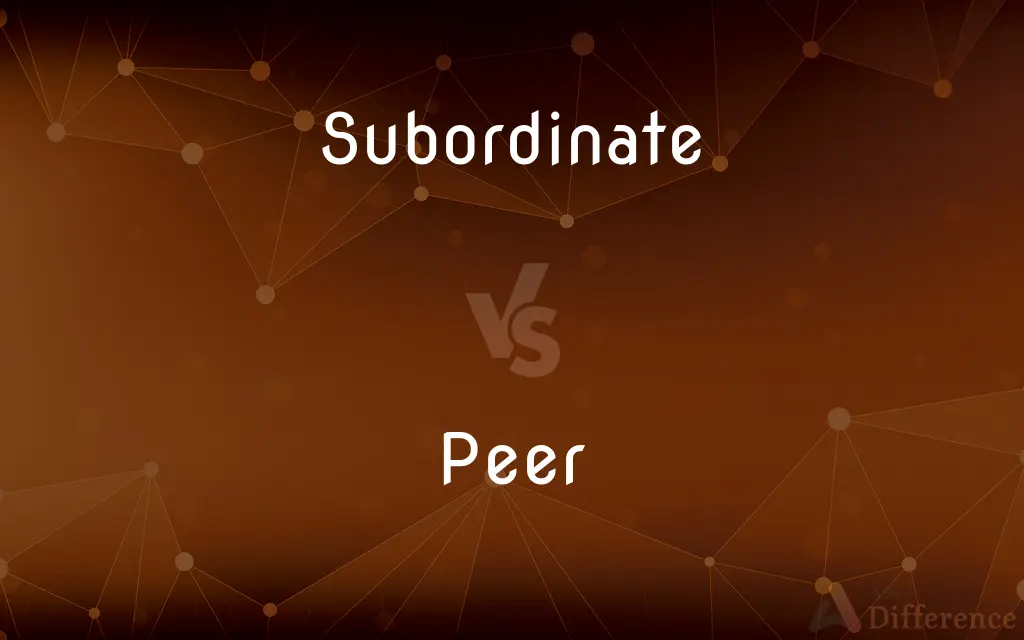Subordinate vs. Peer — What's the Difference?
By Maham Liaqat & Fiza Rafique — Updated on February 25, 2024
A subordinate is someone ranked lower in a hierarchy, answering to superiors, while a peer is an equal within the same level, sharing similar status or rank.

Difference Between Subordinate and Peer
Table of Contents
ADVERTISEMENT
Key Differences
Subordinates are individuals or positions that fall below others in the organizational hierarchy, implying a direct reporting relationship to a superior. This relationship is defined by authority, responsibility, and accountability, where subordinates follow directives from those above them. Peers, conversely, are those on the same level within an organization or group, where no direct authority is exercised by one over the other. The relationship among peers is characterized by collaboration and mutual respect, rather than a reporting structure.
The dynamic between a subordinate and their superior is often formal and structured, governed by defined roles and expectations. This contrasts with peer relationships, which tend to be more informal and based on shared experiences or roles, facilitating teamwork and lateral support. While subordinates might seek approval or guidance from superiors, peers often work together to achieve common goals or solve problems collaboratively.
Subordinates typically receive it from their superiors, who assess their performance and provide direction for growth. Peer feedback, while also valuable, is more about mutual improvement and sharing perspectives, rather than formal evaluation or performance review.
Career progression for a subordinate often involves moving up the hierarchy, potentially to become a peer of those who were once superiors. In contrast, peers may seek to enhance their standing or expertise within their current level, or they may also aim for promotions that change their relationships from being peers to becoming superiors or subordinates with others.
The distinction between subordinate and peer also affects communication and interaction patterns within an organization. Communication with subordinates is often directive, focusing on tasks and objectives, whereas with peers, it tends to be collaborative, aimed at sharing knowledge and achieving consensus.
ADVERTISEMENT
Comparison Chart
Definition
An individual ranked lower in a hierarchy, reporting to superiors
An equal in status or rank within the same group or level
Authority
Receives directives from superiors
Shares equal authority with no direct reporting lines
Relationship Nature
Formal and structured based on hierarchy
Informal and collaborative based on equality
Feedback & Evaluation
Typically from superiors, focusing on performance improvement
Mutual, focusing on shared goals and improvement
Communication
Directive and task-focused
Collaborative and consensus-seeking
Compare with Definitions
Subordinate
Placed in a lower order, class, or rank; holding a lower or inferior position.
The several kinds and subordinate species of each are easily distinguished.
Peer
Equals in a specific characteristic or condition.
Peers in the academic field often review each other's work.
Subordinate
A person under the authority or control of another within an organization
He was mild-mannered, especially with his subordinates
Peer
A person who is matched with another in abilities.
He found it challenging to compete with his peer.
Subordinate
Someone who follows orders from those above in rank.
He often had to do tedious tasks as the subordinate.
Peer
An individual of equal status, rank, or age.
She enjoyed working with her peers on the project.
Subordinate
Rank or order as less important or consider of less value;
Art is sometimes subordinated to Science in these schools
Peer
A person who is of equal standing with another in a group
Subordinate
A position that is lower in status or rank.
The subordinate role required extensive training.
Peer
Someone at the same level in an organizational hierarchy.
As peers, they share responsibilities and collaborate closely.
Subordinate
An individual ranked lower within an organizational structure.
As a subordinate, she reports directly to the department head.
Peer
Members of the same group with shared interests.
The peer group met weekly to discuss their progress.
Subordinate
Lower in rank or importance.
Subordinate tasks were delegated to the interns.
Peer
Somebody who is, or something that is, at a level or of a value equal (to that of something else).
Subordinate
Lower in rank or position
His subordinate officers
Peer
Someone who is approximately the same age (as someone else).
Subordinate
To make of lower priority in order of payment in bankruptcy.
Peer
To make equal in rank.
Subordinate
One who stands in order or rank below another; - distinguished from a principal.
Subordinate
To place in a lower order or class; to make or consider as of less value or importance; as, to subordinate one creature to another.
Subordinate
Lower in rank or importance
Subordinate
Inferior in rank or status;
The junior faculty
A lowly corporal
Petty officialdom
A subordinate functionary
Common Curiosities
How does the role of a subordinate affect team dynamics?
Subordinates play a key role in executing tasks and contributing to team goals, often following the guidance and decisions of superiors, which affects team dynamics through their roles and responsibilities.
What benefits do peer relationships offer in a professional setting?
Peer relationships offer benefits such as shared knowledge, mutual support, collaborative problem-solving, and a sense of camaraderie.
What defines a subordinate in a workplace?
A subordinate is defined by their lower position in the organizational hierarchy, requiring them to report to and follow directives from superiors.
How is a peer relationship different from a subordinate-superior relationship?
A peer relationship is characterized by equality and collaboration without a direct reporting line, unlike the directive and hierarchical nature of a subordinate-superior relationship.
Is feedback between peers as important as between superiors and subordinates?
Yes, peer feedback is important for mutual improvement and collaborative success, while feedback from superiors is crucial for performance evaluation and growth.
What impact does the distinction between subordinate and peer have on organizational culture?
This distinction impacts organizational culture by defining the nature of interactions, the flow of communication, and the approach to collaboration and decision-making within the organization.
Can a subordinate become a peer to their superior?
Yes, through career progression, a subordinate can be promoted to a position where they become peers with their former superiors.
How do peers interact differently than subordinates with superiors?
Peers interact on an equal basis, focusing on collaboration and consensus, while subordinates and superiors interact within a structured hierarchy, often with directive communication.
How can someone transition from being a subordinate to a peer within an organization?
Transitioning from a subordinate to a peer typically involves gaining experience, skill development, and achieving promotions that elevate one's position to the same level as former superiors.
Can peers have authority over each other?
Generally, peers do not have formal authority over each other, as they are considered equals within the same level of an organization.
Share Your Discovery

Previous Comparison
Indifferent vs. Callous
Next Comparison
Restore vs. RepairAuthor Spotlight
Written by
Maham LiaqatCo-written by
Fiza RafiqueFiza Rafique is a skilled content writer at AskDifference.com, where she meticulously refines and enhances written pieces. Drawing from her vast editorial expertise, Fiza ensures clarity, accuracy, and precision in every article. Passionate about language, she continually seeks to elevate the quality of content for readers worldwide.















































